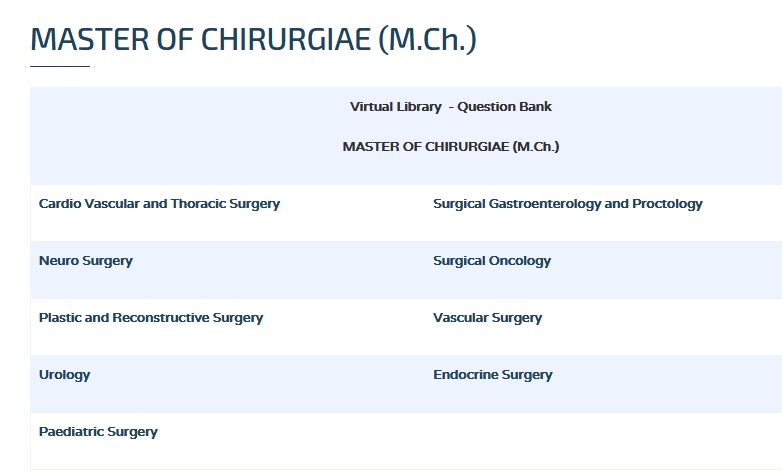Basic Sciences M.Ch Question Bank : web.tnmgrmu.ac.in
Name of the University : The Tamilnadu Dr. M.G.R. Medical University
Degree : M.Ch
Branch : Branch I – Cardio Thoracic Surgery
Subject Code/Name : 1501/Basic Sciences
Paper : IV
Document Type : Question Bank
Website : web.tnmgrmu.ac.in
Download Model/Sample Question Paper :
1990-2000 : https://www.pdfquestion.in/uploads/web.tnmgrmu.ac.in/4514-1-181501KC.pdf
2001-2014 : https://www.pdfquestion.in/uploads/web.tnmgrmu.ac.in/4514-2-181501KU.pdf
TNMGRMU Basic Science Question Bank
Sub. Code: 1501
M.Ch. DEGREE EXAMINATION
Related / Similar Question Paper :
TNMGRMU M.Ch Vascular Surgery Question Bank
(Higher Specialities)
(Revised Regulations)
Branch I – Cardio Thoracic Surgery
Paper I– BASIC SCIENCES
Q.P. Code: 181501

August 2008
Time: Three hours
Maximum: 100 Marks
ANSWER ALL QUESTIONS :
Draw suitable diagrams wherever necessary. :
I. Essays: (2 x 20 = 40)
1. Describe the anatomy of tricuspid valve and discuss the various surgical procedures performed to correct tricuspid regurgitation.
2. Describe the various fungal infections of lung and heart which are of interest to cardiothoracic surgeon and their treatment.
II. Write short notes on: (10 x 6 = 60)
1. Trabecula septomarginalis.
2. Epsilon amino caproic acid.
3. Pneumocystic carinii.
4. Bulbous cordis.
5. Aschoff nodule.
6. Oxygen Dissociation curve.
7. Alveolocapillary membrane.
8. Natriuretic peptide.
9. Blood supply of trachea.
10. Lower oesophageal sphincter.
August 2009
I. Essays: (2 x 20 = 40)
1. Discuss the surgical anatomy of the normal conduction system and outline its importance in various cardiac surgical procedures.
2. Describe the anatomy of the aortic root and outline the various surgical procedures to enlarge small aortic annulus.
II. Write short notes on: (10 x 6 = 60)
1. Left superior vena cava.
2. Ductus arteriosus.
3. Aspergilloma.
4. Anatomy of left internal mammary artery.
5. Pulmonary functions tests.
6. INR.
7. Phospho diesterase inhibitors.
8. Broncho pulmonary segments.
9. PEEP.
10. Cervical rib.

February 2010
I. Essays: (2 x 20 = 40)
1. Describe the development of pulmonary venous system and left atrium. Describe briefly the various anomalies due to maldevelopment.
2. What are the various organisms responsible for Nosocomial infections in recovery rooms and intensive care units? Describe methods of preventing them.
II. Write short notes on: (10 x 6 = 60)
1. Amiodarone.
2. Drug induced colitis.
3. Right ductus arteriosus.
4. Tracheal strictures.
5. Hyponatremia.
6. Diaphragmatic hernia.
7. Mesothelioma.
8. Peek expiratory flow rate.
9. Metabolic alkalosis.
10. Aschoff nodule.
February 2011
I. Essays: (2 x 20 = 40)
1. Describe the normal development of interatrial septum and classify atrial septal defects, Discuss the management of sinus venosus type of ASD.
2. Describe the conduction system of the heart and it anomalies, with its surgical relevance.
II. Write short notes on: (10 x 6 = 60)
1. Atrial Isomerism.
2. Persistent Left Superior Vena Cava.
3. Membrane Oxygenators.
4. Prosthetic valve endocarditis.
5. Flail chest.
6. Bronchogenic cyst.
7. Nooman shumway.
8. Protamine reactions.
9. Milrinone.
10. Surgical Anatomy of Trachea.
August 2011
I. Elaborate on :
1. What perfusion strategy would you adopt for arch Aneurysms? Discuss the technique.
2. A 45 year old person has come up for double valve replacement. What would be your preferred method of Myocardial management?
II. Write notes on :
1. Conduction System in the Heart.
2. Anticoagulants used in Cardiac Surgery and monitoring their levels.
3. Management of ARDS.
4. Nosocomial infections.
5. Anatomy of the Trachea and techniques of mobilization.
6. Options available in Prosthetic Heart Valves.
7. Assessment of the Pulmonary function.
8. Anomalies of the Mitral Valve.
9. Classification of left Ventricular out flow tract obstruction.
10. Treatment of MDR TB.
August 2012
I. Elaborate on :
1. Describe the Broncho pulmonary segments and discuss the aetiopathology and management of Bronchiectasis.
2. Discuss the embryology and anatomy of Interventricular septum.
II. Write notes on :
1. Describe His bundle mapping and its uses.
2. Classify Co-arctation of aorta and its surgical management.
3. Elaborate on additives used in Cardioplegia.
4. Causes and management of Chylothorax.
5. Indications, contra indications, hemodynamics, insertion and weaning of Intra Aortic balloon pump.
6. Surgical management of Pharyngeal diverticulum.
7. Diagnosis and management of Malignant pleural mesothelioma.
8. Central fibrous body, its attachment and structures passing through it.
9. Causes, clinical features and management of ARDS.
10. Atrial pacing.
August 2013
I. Elaborate on :
1. Discuss the technique of total circulatory arrest in infants with complex defects coming up for surgical correction.
2. Pathology of reperfusion injuries and techniques to lessen impact of reperfusion injuries.
II. Write notes on :
1. Compare the anatomy of the right versus left pulmonary artery.
2. Blood supply of trachea and bronchus.
3. Diagrammetically show the lymph nodal stations in the mediastinum and thoracic cavity.
4. Dysphagia lusoria.
5. Anatomy of the aortic root.
6. Anatomy of the sternum and methods useful in preventing dehiscence.
7. Anatomy of right ventricular outflow tract.
8. Diagnosis of pulmonary embolism.
9. Etiology of mitral stenosis.
10. Left SVC embryology and surgical relevance.